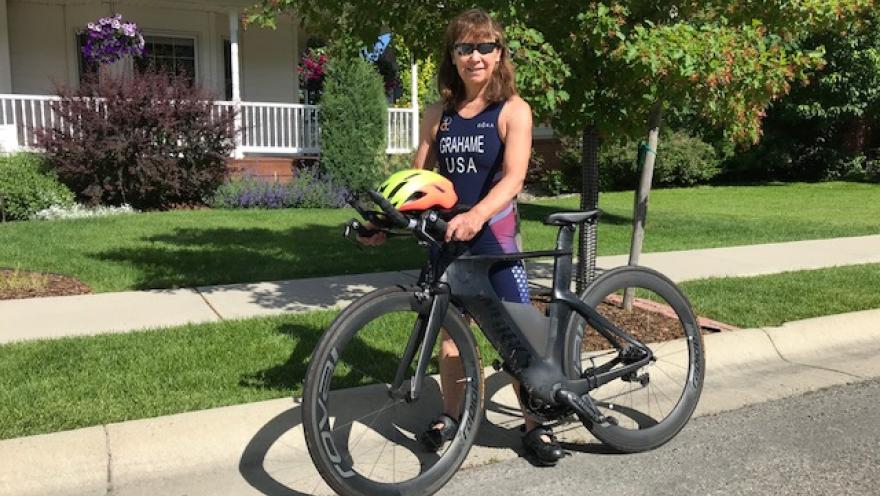By Heather Grahame
One day you find you’re having trouble tying your shoes and buttoning your shirt. After many months, numerous doctor visits, and a battery of tests, you’re told you have ALS.
An ALS diagnosis is unbelievably crushing. The impact is impossible to fully appreciate until it hits you or someone you know. The disease is a monster, and it only has one direction. You progress until you can no longer eat, speak, walk, or breathe. Research into finding a cure is vital. That’s why I run, bike, and swim.
My brother, Tom, was diagnosed with ALS in October 2016. He and his wife, Jan, are responding as positively as possible.
Tom has decided to use his ALS as a means of advancing scientific research. He researched ALS in depth and, with the help of his ALS doctor at Georgetown University, chose to take a drug called Tasigna. The drug was originally developed to treat cancer, but it seems to have slowed his progression and reduced some of his symptoms.
I marvel at the way Tom and Jan have committed to finding joy in every day and found creative ways of adapting to Tom’s physical changes. For example, I love how Jan keeps jar lids loose in the refrigerator, so a person with one working arm and hand can still open the refrigerator, grab a jar, and find a way to open it.
Although I live in Montana and Tom lives in Washington, D.C., we keep in regular contact through phone dates, usually late Sunday afternoons. I also fly back to D.C. as often as I can. But, the phone communication is key, and we’ll need to figure out how to communicate after Tom loses his ability to speak. (His speech is impaired now.)
I’ll admit that Tom’s diagnosis devastated me. At first, I wept. Then, I set out to find a way to help find a cure for ALS.
In addition to having a more-than-full-time job as vice president and general counsel for an energy company, I’m an athlete who has been regularly racing in triathlons for about six years.
I started with short, sprint triathlons and steadily increased the length of my races to a full IRONMAN in 2016 (2.4-mile swim/112-mile bike/26.2-mile run). I also qualified for and raced in the 2016 IRONMAN 70.3 World Championships in Australia (1.2-mile swim/56-mile bike/13.1-mile run).
After going to The ALS Association website, I discovered that Team Challenge ALS would be participating in the 2017 New York City Triathlon. I signed up immediately and raised over $3,500 for The ALS Association.
That triathlon was one of my favorite races of all time, because I was raising money for a cause. Racing is a completely different experience, and far more satisfying, when you can use the race as a means to help others.
I’ve also been raising money for The ALS Association by logging my workouts with the “Charity App” on my mobile phone. Through that app, miles trained on my outdoor workouts earn dollars donated by various businesses to my charity of choice. In my case, that’s The ALS Association.
I’m committed to helping find a cure for ALS through fundraising. Combining my training and racing with a fundraising objective is one way I can make a difference. And that difference can be real.
A few years ago, I met a triathlete who, early in her triathlon racing, raised money for leukemia and lymphoma research due to a friend’s illness. That triathlete subsequently developed leukemia herself.
Amazingly, the drug that put her leukemia into remission was one that her fundraising had helped bring to market. Can anyone doubt that individual contributions can have a lasting impact?
In 2017, I competed in the USA Triathlon Aquabike National Championships, finishing third in my age group (60-64). The race involved a 1.2-mile open water swim, followed by a 56-mile cycling time trial. My third-place finish qualified me to race for Team USA in the upcoming 2018 International Triathlon Union World Championship in Denmark on July 14, 2018.
That event involves five different world championships (duathlon, cross triathlon, aquathlon, long-distance triathlon, and the aquabike). Over 3,500 athletes from around the world are expected to participate, including 600 athletes racing for Team USA.
Every day that I train, and in every race that I participate, I’m profoundly grateful for having the health and the opportunity to do so. My participation in the 2018 World Championships gives me a larger platform on which to raise funds for ALS research. My fundraising goal is at least $5,000.
I believe a lack of funding is the only obstacle to finding a cure for ALS. Fortunately, through the 2018 World Championships, I have the opportunity to make a difference.
Team Challenge ALS participants combine their passion and commitment to finding a cure for ALS with achieving physical challenges through athletic events, such as marathons, cycling events, winter sports, obstacle course races, and other endurance activities.
Join the fight against ALS by joining a Team Challenge ALS event near you or creating your own event. Click here to get started today.


Join the conversation. Please comment below.